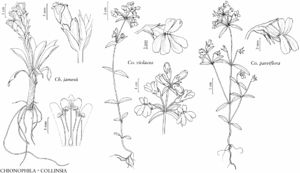Difference between revisions of "Chionophila"
Prodr. 10: 331. 1846.
imported>Volume Importer |
(No difference)
|
Latest revision as of 19:04, 29 July 2020
| Taxon | Illustrator ⠉ | |
|---|---|---|
 | Chionophila jamesii Collinsia violacea Collinsia parviflora | Barbara Alongi Barbara Alongi Barbara Alongi |
Herbs, perennial; caude× woody or herbaceous. Stems erect, glabrous or puberulent. Leaves basal and cauline, cauline smaller, opposite, sometimes alternate distally; petiole present or absent; blade not fleshy, ± leathery or not, margins entire. Inflorescences terminal, spikelike, secund racemes; bracts present. Pedicels present or absent; bracteoles absent. Flowers bisexual; sepals 5, proximally connate, caly× radially symmetric, cylindric to funnelform, lobes triangular to narrowly ovate; corolla greenish white, creamy white, or pale lavender, bilaterally symmetric, bilabiate, tubular-funnelform, tube base not spurred or gibbous, throat not densely pilose internally, lobes 5, abaxial 3, adaxial 2; stamens 4, proximally adnate to corolla, didynamous, filaments glabrous; staminode 1, ± filiform; ovary 2-locular, placentation axile; stigma capitate. Fruits capsules, dehiscence septicidal. Seeds 10–20, tan or brown, ellipsoid to fusiform or ellipsoid-disciform, wings present. x = 8.
Distribution
w United States
Discussion
Species 2 (2 in the flora).
Chionophila shares morphological similarities with Penstemon, most notably an epistaminal nectary of glandular hairs. Both have a base chromosome number of eight. R. M. Straw (1966) hypothesized that they are sister taxa. Relationships among genera in Cheloneae remain equivocal (A. D. Wolfe et al. 1997, 2002, 2006; S. L. Datwyler and Wolfe 2004). Chionophila is distinguished from Penstemon by a more prominent caly× tube, spikelike racemes, prominently winged seeds, and absence of bracteoles.
Selected References
None.
Lower Taxa
Key
| 1 | Verticillasters continuous; caly× tubes 8–9 mm. | Chionophila jamesii |
| 1 | Verticillasters interrupted; caly× tubes 1–2 mm. | Chionophila tweedyi |